-
Posts
3,496 -
Joined
-
Last visited
-
Days Won
25
Content Type
Profiles
Forums
Blogs
Gallery
Events
Store
Posts posted by bigjarofwasps
-
-
Hi Guys,
Does anyone know what medal(s) were awarded to British soldiers for this campaign?
Gordon.
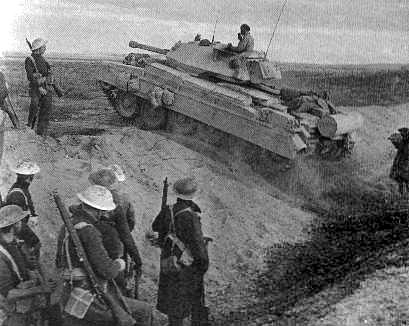
 0
0 -
Omani Bedu silver necklace......
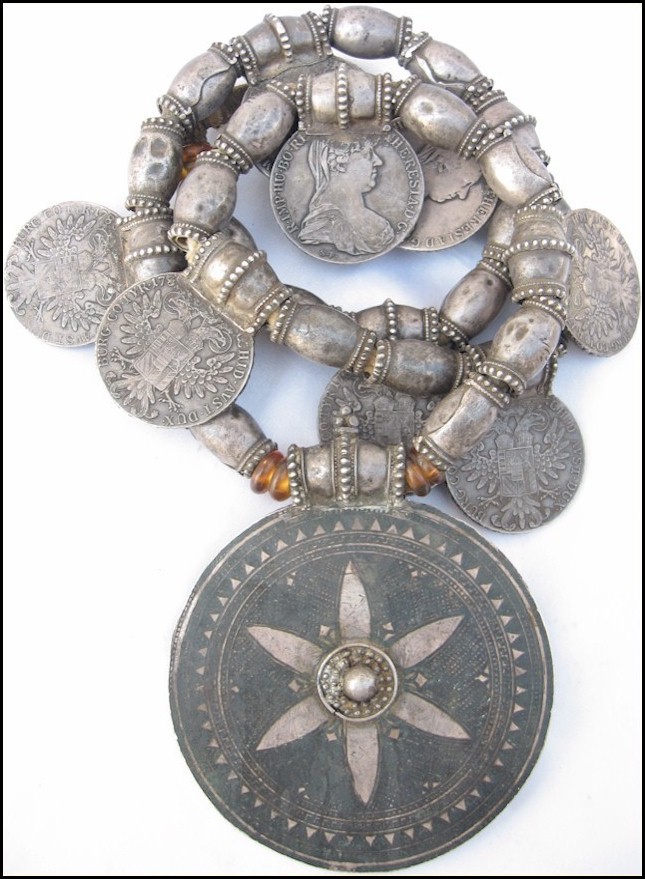
 0
0 -
A beautiful example of a Thaler made into jewellery.
Traditionally silver Yemen jewelry has represented a long term financial investment for families as well as being valued for its protective qualities. It was presented to the bride by the groom's family in the form of a dowry and considered her property and part of the household wealth. Gold is now the dowry gift of choice.
Jewelry making in Yemen is closely connected to Jewish craftsmen who settled there in ancient times and for centuries they were responsible for most of the jewelry produced. Techniques such as filigree and granulation were developed before the advent of Islam.
When the state of Israel was created in 1948 almost the entire Jewish population in Yemen, including the craftsmen, immigrated. The craftwork produced after this exodus lacked the expertise and refinement of the Jewish craftsmen. Older pieces produced by the Jewish craftsmen are held in high regard and today are referred to as "Jewish work".
Some of these ornaments, usually of a particular style, were stamped with the Hebrew name of the maker in Arabic characters. The centuries old techniques are used today by Jewish craftsmen in Israel.
Traditional silvermaking techniques are not completely lost in modern day Yemen and on recent visits to Sanaa I have noticed silver ornaments being produced that rival the skill level of the early Jewish craftsmen.
******************************************************
A vintage piece of bedouin jewelry which would have been worn at the forehead. The centerpiece is a Maria Teresa thaler which was the main source of silver for vintage and antique jewelry.
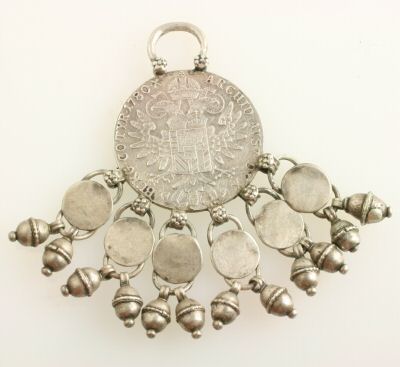
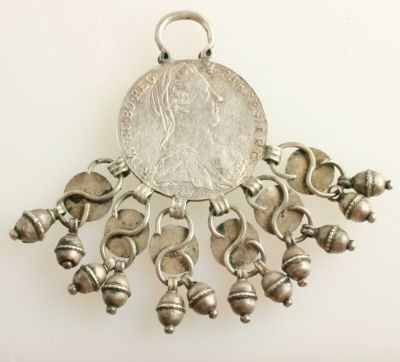

 0
0 -
Inscribed by hand with the name C Watts, Baghdad 1917 18 19. This is a time when the British army was stationed in present day Iraq.
The coin on the lid of the box is an Ottoman coin dated 1327 which corresponds to 1909.
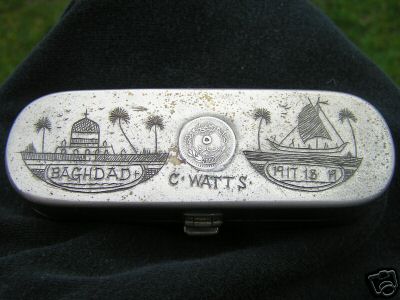
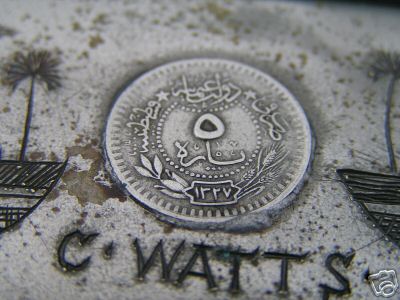

 0
0 -
A 1930`s Iraqi niello solid silver cigarette / cigar / card case.
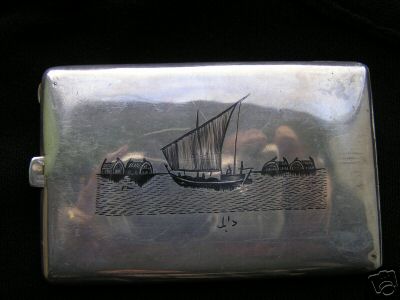
 0
0 -
The case incorporates quality nielloed designs typical of Iraqi silversmiths, ie important local mosques and scenes from the river Tigris and the Shatt-al-Arab waterway.
Inscription inside - Abadan December 1936. Abadan was (and still is) an oil terminal and port just on the Iranian side of the shatt al arab.
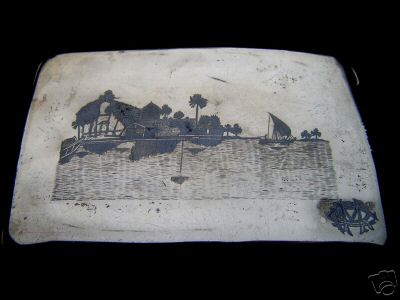


 0
0 -
Solid silver nielloed Box or compact made in Maysan province of southern Iraq by Marsh Arabs.
On one side is a type of boat that used to be a typical sight on the Tigris river and the southern marshes near to the border with Iran.
On the other side there is a picture of a man riding a camel.



 0
0 -
The box incorporates quality designs typical of Iraqi silversmiths, ie important local mosques and scenes from the river Tigris and the Shatt-al-Arab waterway.
Iraqi silversmiths were usually Mandean Christian. They typically employed nielloed designs and are acknowledged to have been very skilled. These Silversmiths were based mainly in Baghdad, Basra and around Maysan province which is in the southern marshes.
In recent years the number of Mandean Christians in Iraq has fallen dramatically and partly as a result of this, nielloed Iraqi silver has become very collectable and pricey.
This box seems to date from the 1920's and it exudes atmosphere.
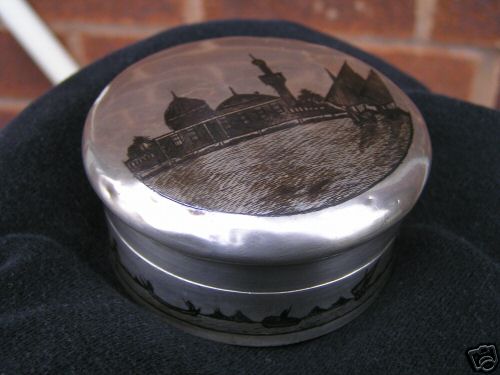
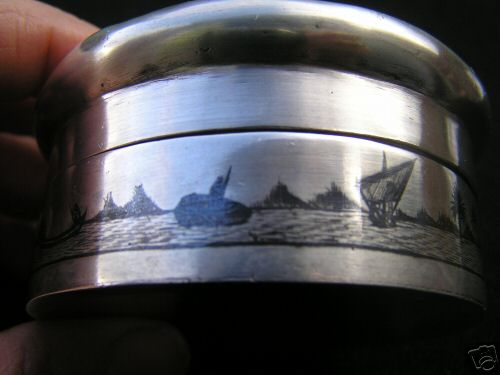

 0
0 -
Thursday, 13 December 2007
Guardsman Stephen Ferguson has died following a road accident in southern Iraq, the Ministry of Defence has said.
A member of 1st Battalion The Scots Guards was involved in the accident in Basra province on Wednesday.
He had been flown to the UK for treatment after the accident involving a Warrior Armoured Vehicle.
The soldier's next of kin have been informed of the death, which takes the number of UK troops killed in operations in Iraq since 2003 to 174.
He was initially taken to the field hospital at the UK base at Basra Air Station.
There will be a 24-hour period of grace for the soldier's family before more details are released by the MoD.
The death comes just three days before British forces are due to hand over control of security in Basra province to the Iraqi authorities.
The 4,500 UK troops in Iraq will focus on the training of Iraqi security forces. Numbers will fall to 2,500 from next spring.
Last month, two military personnel died when their Puma helicopter crashed near Baghdad. An inquiry will investigate the incident.
0 -
Anyone any ideas, where these coins were minted?
Shame that they didn`t use silver for the 100 Dinar coin....but I suppose given the circumstances..
0 -
Found this example of Niello, thought it might be of interest....
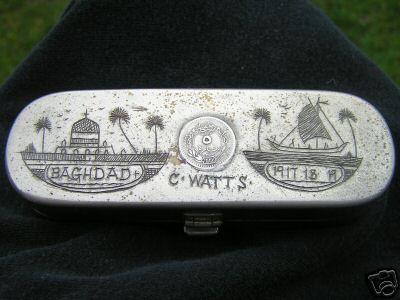
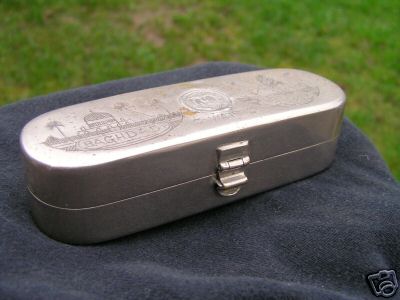



 0
0 -
Picture from Owain's Collection:
Thank you Owain
God Bless
SSG Luna, Lorenzo
Lorenzo, is anything known about these medals? Who they were awarded to, and for what?
Gordon.
0 -
I suppose a good place to start might be...

 0
0 -
Its surprising just how small they are, no wonder they lost so many...


 0
0 -
Heres a few examples of silver ones I`ve seen that wouldn`t break the bank...


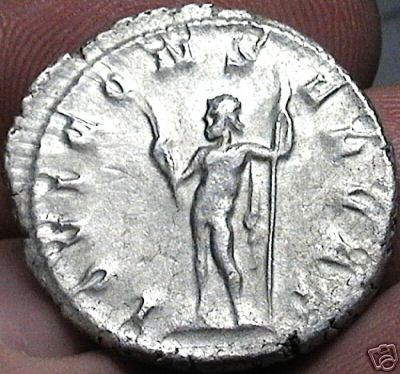

 0
0 -
Anyone out there into roman coins?
Was thinking of maybe starting a collection,
 any tips?
any tips?I see that the gold examples are for the big boys, so will have to set my sights a little lower. Maybe silver ones...

 0
0 -
Phew, can we put this one to bed now?

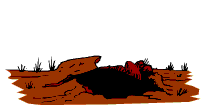
 0
0 -
I don't think you are being that skeptical. However, there certainly isn't wholesale awards to entire units going on and there is definetly variations in "scale" depending upon the unit (e.g. the Commander). My friend "We'll give everyone a puppy", Kevin is back from the Afghan mountains this month and he certainly earned his CIB. However, he knows of some guys who did not do that much work to get theirs.
 This speaks volumes....
This speaks volumes....  0
0 -
I have reviewed AR 670-1 & AR 600-8-22.
The Awards for the Combat Infantry & Combat Medical Badges are consistent one to the other.
One award only is authorized for the periods – WWII (1941-45), Korea (1950-53), Vietnam Era Conflicts (1961-95 through Somalia) & War on Terror beginning with Afghanistan including the two Iraqi conflicts with no end date established.
The Combat Action Badge is recently established and applies only to the last period.
These groupings dictate eligibility for multiple awards.
There is provision for a soldier to win all three and wear two of the three if one is the CMB. All three must involve engagement with the enemy. If more than one combat badge is awarded it must be for different service assignments - not simultaneous.
Generals are not eligible for the CIB or CMB.
Special Forces Medical MOS personnel are eligible to exchange CMB for CIB for action subsequent to September '01 until June '06. After June '06, SF Medical personnel (MOS 18D) will be eligible for the CIB but not the CMB.
CIB relates to assignment to Infantry units to include Special Forces, Infantry Squads of ground cavalry organizations and the like. Officers (other than infantry) on “temporary detail” to infantry units who meet all other criteria may be awarded the CIB.
A soldier may wear a maximum of 5 badges of varying types as follows:
Either CIB, EIB or CAB
and
Either CMB or EMB
and
One from Astronaut, Aviator, Flight Surgeon, Aviation (formerly flight crew), Explosive Ordnance
and
Up to 3 from Glider, Parachutist, Pathfinder, Free Fall, Air Assault, Ranger & Special Forces
and
Up to 2 from the Diver, Driver, Mechanic, Rigger group.
A maximum of 3 badges may be worn on the pocket flap of the dress uniform including marksmanship badges.
Phew - I think I have a headache!
Right I think that sorts that out...?? Interesting that a medic attached to the SF would get a CIB & not a CMB?
Also that you could wear the CAB & CMB/CIB?

 0
0 -
apparently.
I have spoken to a number of guys who have these CABs and most were support troops (clerks, computer techs, truck divers) who were in a combat incident or two (shot at) /and/or got mortared.
 The mortar one is a bit lame I think, & by that I mean if a camp is huge like say SLB in Basra was, rounds could land on camp, but be up to a mile away from where the clerk was (he might not even hear them), would this still count.....surely not???
The mortar one is a bit lame I think, & by that I mean if a camp is huge like say SLB in Basra was, rounds could land on camp, but be up to a mile away from where the clerk was (he might not even hear them), would this still count.....surely not???What about the other example, where a lone Iraq fires one pistol round at your vehicle as you drive passed....contact with the enemy?? I assume said incident would have to be called in on the radio in order to count, that being the case I wonder how many incidents like that go unreported, and how many are `beefed` up a bit by rear echelon units, in order to qualify...or am I being a sceptic?

 0
0 -
Nope-true story. Only the guy was a Sergeant (well, he is now) and in a National Guard unit. I spoke to him 2 months ago at the Maine Boy Scout Jamboree. He is now the local recruiter and lives @ 15 miles from my house.
His one other "action" was to watch the aftermath of a suicide bomber after he'd been shot running towards the guard post at the base.
Hi Ulster, nice to hear from you again.....
So basically its down to the discretion of your commander at the time, whether he/she deems that you participation in an incident, and the incident in general is worthy of said award? There appears to be no hard & fast rules?

Gordon.

 0
0 -
Remember, you have to be attached to a specific unit to qualify for the CMB. If you aren't (attached to a CSH for example) and were in that situation-you would get a CAB, not the CMB.
You have to be engaging or be engaged (i.e. bullets coming at you, mortars incoming from the enemy, etc.). So post care would not count.
A medic could only have a CIB and CMB if he were infantry and medical MOS qualified and came under fire. I would assume two separate instances would dictate two awards.
I believe the reg states that you can only wear only one "group one" badge. This would include the CMB, CIB, CAB, EFMB, EIB. So if you have both, you can only wear one. I will double check on this.
Roger all that Armydoc, it all becomes clear!!!!

But I wonder if you have any opinion as to what `actively engaged` might mean?
0 -
Thanks for the information, Armydoc. Also welcome to the GMIC.

Yes I agree, welcome to the forum Armydoc, your a wealth of information, I hope you enjoy visiting the forum as much as we have enjoyed reading your replies!!!!!
0 -
I must say, I`ve made a monster here!!

I was amazed to here that a medic can qualify for a CAB & CMB. But it does make perfect sense I suppose, as I know of loads of medics that were out of the ground, got into scuffle, but didn`t treat anyone. Thus I suppose they would qualify for a CAB. What would happen if they ended up earning both somehow could they wear them both or would they have to choose, I suppose if they somehow won two of one and one of the other they`d wear the one with the star, but what of the other. I asume that would just be on there records or something?
But what do you have to do to qualify for a CAB as a medic? Would the example where one pistol round had been firded at you, by an angry Iraqi as you drove passed on top cover count, or would it have to be a sustained burst of AK, or the like? I assume you have to have infact returned fire?
What about attending a post IED incident, where you treated wounded, but all the `shooting & loud bangs` had finished...But a further return to shooting could in theory happen again at anytime?....CMB, CAB or nothing.
Either way, I must say that this CAB seems to be a good idea, and puts pay to all the other elements of the military that aren`t infantry, but involved in a combat none the less!

 a monster indeed....
a monster indeed....Have a look at this...
It appears you can be awarded all three, but it doesn`t state whether you could wear all three at once?
It also goes on to state..
c. Soldier must be personally present and actively engaging or being engaged by the enemy, and performing satisfactorily in accordance with the prescribed rules of engagement.
....but doesn`t stipulate what actively engaged might mean...anyone got any ideas?

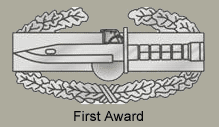
 0
0




Arab Free Corps?
in Middle East & Arab States
Posted
Hi Guys,
Can anyone tell me anything about this unit, or point me in the right direction? Did they fight againest the British in Iraq?
Gordon.